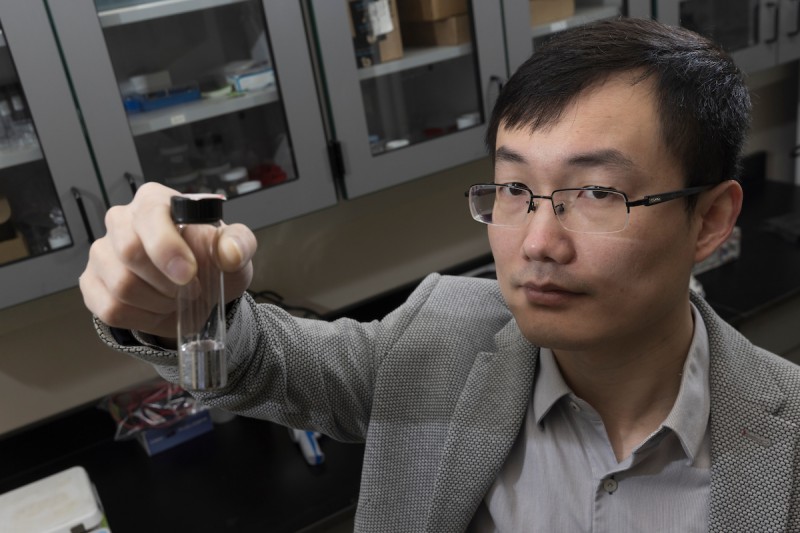For hundreds of years, scientists and engineers have relied on analytical formulas to codify important material laws. For instance, Hooke's law defines a material's elastic properties, and Ohm's law calculates the relationship between voltage, current and resistance in an electrical circuit.

Material laws today, however, are far more complicated. Here's one example from Binghamton University Assistant Professor Pu Zhang's research: The electrical conductivity of a soft conductive material, an important component in soft electronics, is generally mapped out as a tensor function form in 12-dimension space.
Recognizing those patterns and breaking them down into simple-to-use mathematical formulas can take years - often decades - of experimentation and derivation, even for the most skilled scientists and engineers.
Zhang, a faculty member at the Thomas J. Watson College of Engineering and Applied Science's Department of Mechanical Engineering, wants to speed up the material law discovery process with artificial intelligence, and a recent $294,992 grant from the National Science Foundation will fund his research.
Thanks to the launch of ChatGPT last fall, both the promises and pitfalls of AI systems moved into the cultural mainstream. AI is nothing new, though: Researchers have been refining and improving the technology since the 1950s.
Over the past few years, Zhang has studied the conductive properties of liquid metal materials. In 2022, he received an NSF CAREER Award to explore his ideas about liquid metal networks in soft electronics that can bend or stretch without breaking.
He will collaborate with Assistant Professor Lin Cheng at the Worcester Polytechnic Institute in Massachusetts to develop a new AI technique to generate analytical material laws.
"If we have raw data about how a material's physical properties change during deformation, we aim to find the specific mathematical formulas of material laws," Zhang said. "It used to take years to develop one new law. Now with these AI algorithms, maybe in a day you can discover a lot. This will revolutionize the whole field."
To figure out a new path, Zhang and Cheng will look to symbolic AI, which interprets and generates equations instead of words as ChatGPT does.
"People have developed plugins you can add to ChatGPT to interpret simple mathematical equations, mostly on a K to 12 level," Zhang said. "For university research, what we need is very advanced math on a graduate-school level, and this is still something ChatGPT - even the add-ons - cannot do."
The researchers also hope to shed more light on the opaque way that AI often works, which makes results difficult to adjust and interpret.
"A mainstream approach in the past few years has been AI and data-based modeling," Zhang said. "They train a huge neural network that's like a black box - you input data, you get output data, that's it. Nobody knows what's really going on in the black box. It's very hard to use because you download a code and not a mathematical formula you can use directly."
Another recurring problem with AI algorithms: They sometimes offer plausible responses that are completely wrong - a phenomenon that computer programmers call "hallucinations." For instance, it might incorrectly summarize a book that an author never wrote or cite legal precedents that never actually happened.
While clearly any formulas will need to be checked through experimentation, Zhang hopes that "hallucinations" and other troubling output can be avoided.
"One advantage of our symbolic AI technique is that we have a firm mathematical foundation, which will add all the physical constraints with material laws automatically," he said. "At least it won't be too wrong, and it will help the algorithm to find the right functions."
Zhang and Cheng submitted their proposal to the NSF before the nonprofit OpenAI launched ChatGPT, but now it's a hot topic for researchers, students and the tech industry. Although they are developing their software to solve materials science problems, the principles could be applied to many different endeavors that seek analytical formulas from raw data.
"It's a big time for AI, not only for computer science but for all other scientific fields," Zhang said. "Before ChatGPT, the research community was still conservative about AI - many people were still against it. People would say it's a black box or it's curve-fitting to predict a desired outcome. After ChatGPT, many people changed their minds. They started to recognize the potential of AI and embrace it."
At the end of the three-year project, the researchers plan to host a website where users can upload data and let the algorithm develop relevant equations for teaching and research purposes. From there, they could expand through further funding to boost hardware and software capabilities or license the technology to a software company.
Zhang admits he's not sure how AI will change his research, academia or society in general, but he expects many things will shift in a short time.
"This area is developing very, very quickly," he said. "Within five to 10 years, we will see a revolution. I've never seen such a situation before. In the past 20 years, we have seen so many leaps in nanotechnology, energy and 3D printing, but this wave of AI feels different."







